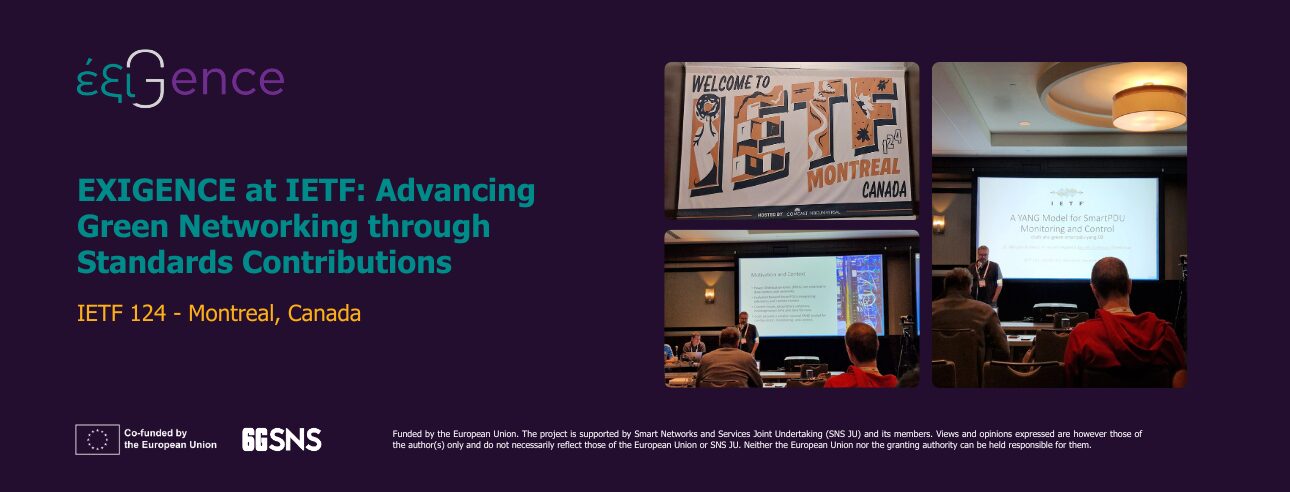
Why Standardisation Matters for Green Networking
EXIGENCE is driving concrete standardisation contributions to the IETF that translates research into implementable interfaces and data models for energy-aware network operation. In this blog we summarise five internet-drafts produced or supported by EXIGENCE and contributed to the recent IETF 124 meeting hold in Montreal, Canada, during the first week of November. The contributions referred to here have been presented in either the Getting Ready for Energy-Efficient Networking (GREEN) working group from IETF [1], and Sustainability and the Internet (SUSTAIN) research group from IRTF [2].
Deep Dive - What Each Contribution Delivers
Use Cases for Energy Efficiency Management
Use Cases for Energy Efficiency Management (draft-stephan-green-use-cases [3]). This document is a compendium of use cases, from incremental device-level energy management to media-streaming carbon transparency and carbon certificates as a service, that validates why APIs and YANG models are needed and how they will be consumed. The document bridge the gap between research concepts and deployable features. They guide the design choices for PETRA, SmartPDU and the GREEN framework (described later), ensuring the standards work addresses real industrial needs. In terms of EXIGENCE contribution, project use cases have been considered as base for the document.
Framework for Energy Efficiency Management
Framework for Energy Efficiency Management (draft-belmq-green-framework [4]). This document described a reference model and management framework that focuses on devices and device components (line cards, fans, PDUs, meters) and prescribes how timestamped telemetry, capability discovery, intent mapping and device safety (transition limits) should be represented. The framework organises device-level functions into a coherent architecture that higher-level APIs (like PETRA, described next) can rely on for accurate, verifiable measurements and safe control actions. It also proposes the power topology model and the Power Interface abstraction used by orchestration layers. This framework is consistent with EXIGENCE approach for collecting, retrieving and reporting energy-related information from network domain.
Path Energy Traffic Ratio API (PETRA)
Path Energy Traffic Ratio API (PETRA) (draft-petra-green-api [5]). The document proposes an API to query the energy characteristics of a network path (watts-per-gigabit), together with a YANG module representation for machine consumption and recursive aggregation of subpaths. PETRA intends to provide a standardised interface that allows orchestrators, controllers and service managers to make path selection and SLA decisions informed by energy and carbon attributes. The recursive model and a YANG module make the API usable in hierarchical SDN/Orchestration setups.
Path Energy Traffic Ratio API (PETRA) Augmented
Path Energy Traffic Ratio API (PETRA) Augmented (draft-malja-sustain-petra-augmented [6]). This related draft augments the API defined in the previous one by refining the specification and aligning outputs with metrics required by green service intents, including aspects such as carbon intensity, energy mix, greenness percentage, PUE, etc. It ensures consistent semantics across implementations and documents a RESTCONF/YANG mapping for practical integration into existing management stacks.
A YANG Model for SmartPDU Monitoring and Control
A YANG Model for SmartPDU Monitoring and Control (draft-ahc-green-smartpdu-yang ). The document describes a YANG data model for Smart Power Distribution Units (SmartPDUs) exposing outlet-level telemetry, sensors, thresholds, and remote-control capabilities. Many PDUs are proprietary, thus a standard YANG model enables multi-vendor integration, real-time aggregation of energy data, automated policies (load balancing, power capping), and direct coordination between physical power infrastructure and software power management. It is important to note The SmartPDU model was prototyped during an IETF hackathon organised by EXIGENCE [8] during IETF 123 in Madrid, Spain, which engaged actors external to the project such as manufacturers (e.g., Cisco), associations (Greening of Streaming), SMEs (All for Eco), etc.
Cross-cutting Technical Advantages and Industrial Relevance
The relevance of these activities in IETF are many-fold:
- Interoperability: YANG-based models (SmartPDU, PETRA YANG) and RESTCONF mappings enable consistent vendor-neutral integration across controllers, network management systems and orchestrators. This is the intrinsic scenario of EXIGENCE where multi-domain aggregation is enforced.
- Verifiability: Timestamped telemetry and explicit power topology modeling reduce ambiguity and double-counting risks when aggregating energy across domains, which is also key in EXIGENCE.
- Automation: Capability discovery and intent-to-device mapping in the management framework make it feasible to automate energy-aware control without compromising safety.
- Market Mechanisms: The use cases and models reported create the substrate needed for the elaboration of carbon certificates, green SLAs and energy-aware pricing models.
All these outcomes are building blocks for alignment with EU climate and digital transition goals by enabling transparency, measurement and control at the infrastructure layer, becoming key enablers for regulatory compliance and sustainable procurement. These documents provide practical, implementable artefacts (APIs and YANG modules) that can be progressed through standardisation with the expectation of being finally implemented by device vendors, operators and orchestration platforms. It should be noted that after IETF 124, the adoption process has started for the use cases’ document, being next the framework one. Being successful in this process of adoption and implementation, operators and cloud providers will get standardised tools to measure and optimise energy use, lower OPEX, meet ESG targets and offer differentiated ‘green’ services to customers.
References
- https://datatracker.ietf.org/group/green/about/
- https://datatracker.ietf.org/rg/sustain/about/
- https://datatracker.ietf.org/doc/draft-stephan-green-use-cases/
- https://datatracker.ietf.org/doc/draft-belmq-green-framework/
- https://datatracker.ietf.org/doc/draft-petra-green-api/
- https://datatracker.ietf.org/doc/draft-malja-sustain-petra-augmented/
- https://datatracker.ietf.org/doc/draft-ahc-green-smartpdu-yang/
- https://wiki.ietf.org/en/meeting/123/hackathon#green-framework-and-use-cases
Author

Telefónica Innovación Digital
Luis M. Contreras, Ph.D, is with Telefónica Innovación Digital / CTIO, working on scalable transport networks. He participates in several EU Research and Innovation projects (lately Horizon Europe CODECO, and SNS DESIRE6G, 6GREEN, EXIGENCE, and UNITY-6G). He is an active contributor to different SDOs, such as IETF, O-RAN, ETSI, etc.
